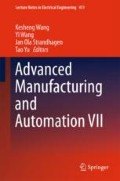Abstract
Fault feature extraction is the key for fault diagnosis, and automatic feature extraction has been a hot topic recently. Deep learning is a breakthrough in artificial intelligence and known as an automatic feature learning method. One of the most important aspects to measure the extracted features is sparsity. Thus, this paper presents a stacked sparse autoencoder (SAE)-based method for automatic feature extraction and fault diagnosis of rotating machinery. The penalty term of the SAE can help automatically extract sparse and representative features. Experiments and comparisons are conducted to validate the effectiveness and superiority of the proposed method. Results fully demonstrate that the stacked SAE-based diagnosis method can automatically extract more representative high-level features and perform better than the traditional intelligent fault diagnosis method like artificial neural network (ANN).
Access this chapter
Tax calculation will be finalised at checkout
Purchases are for personal use only
References
He Q, Wang J, Liu Y et al (2012) Multiscale noise tuning of stochastic resonance for enhanced fault diagnosis in rotating machines. Mech Syst Signal Process 28:443–457
He Q, Ding X (2016) Sparse representation based on local time–frequency template matching for bearing transient fault feature extraction. J Sound Vib 370:424–443
Lu C, Wang Z, Zhou B (2017) Intelligent fault diagnosis of rolling bearing using hierarchical convolutional network based health state classification. Adv Eng Inform 32:139–151
Hannun A, Case C, Casper J et al (2014) Deep speech: scaling up end-to-end speech recognition. Computer Science
Toshev A, Szegedy C (2014) Deeppose: Human pose estimation via deep neural networks. In: Proceedings of the IEEE conference on computer vision and pattern recognition, pp 1653–1660
Johnson R, Zhang T (2014) Effective use of word order for text categorization with convolutional neural networks. Eprint Arxiv
Chen ZQ, Li C, Sanchez RV (2015) Gearbox fault identification and classification with convolutional neural networks. Shock Vib 2:1–10
Tamilselvan P, Wang P (2013) Failure diagnosis using deep belief learning based health state classification. Reliab Eng Syst Saf 115:124–135
Jia F, Lei Y, Lin J et al (2016) Deep neural networks: a promising tool for fault characteristic mining and intelligent diagnosis of rotating machinery with massive data. Mech Syst Signal Process 72:303–315
Shao H, Jiang H, Zhao H et al (2017) A novel deep autoencoder feature learning method for rotating machinery fault diagnosis. Mech Syst Signal Process 95:187–204
Guo X, Chen L, Shen C (2016) Hierarchical adaptive deep convolution neural network and its application to bearing fault diagnosis. Measurement 93:490–502
Acknowledgements
This research was financially supported by the National Natural Science Foundation of China (Grant No. 51505311 and 51375322), the Natural Science Foundation of Jiangsu Province (No. BK20150339) and the China Postdoctoral Science Foundation funded project (2016T90490).
Author information
Authors and Affiliations
Corresponding author
Editor information
Editors and Affiliations
Rights and permissions
Copyright information
© 2018 Springer Nature Singapore Pte Ltd.
About this paper
Cite this paper
Qi, Y., Shen, C., Liu, J., Li, X., Li, D., Zhu, Z. (2018). An Automatic Feature Learning and Fault Diagnosis Method Based on Stacked Sparse Autoencoder. In: Wang, K., Wang, Y., Strandhagen, J., Yu, T. (eds) Advanced Manufacturing and Automation VII. IWAMA 2017. Lecture Notes in Electrical Engineering, vol 451. Springer, Singapore. https://doi.org/10.1007/978-981-10-5768-7_39
Download citation
DOI: https://doi.org/10.1007/978-981-10-5768-7_39
Published:
Publisher Name: Springer, Singapore
Print ISBN: 978-981-10-5767-0
Online ISBN: 978-981-10-5768-7
eBook Packages: EngineeringEngineering (R0)

